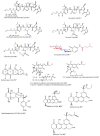Novel Marine Secondary Metabolites Worthy of Development as Anticancer Agents: A Review
- PMID: 34641312
- PMCID: PMC8510081
- DOI: 10.3390/molecules26195769
Novel Marine Secondary Metabolites Worthy of Development as Anticancer Agents: A Review
Abstract
Secondary metabolites from marine sources have a wide range of biological activity. Marine natural products are promising candidates for lead pharmacological compounds to treat diseases that plague humans, including cancer. Cancer is a life-threatening disorder that has been difficult to overcome. It is a long-term illness that affects both young and old people. In recent years, significant attempts have been made to identify new anticancer drugs, as the existing drugs have been useless due to resistance of the malignant cells. Natural products derived from marine sources have been tested for their anticancer activity using a variety of cancer cell lines derived from humans and other sources, some of which have already been approved for clinical use, while some others are still being tested. These compounds can assault cancer cells via a variety of mechanisms, but certain cancer cells are resistant to them. As a result, the goal of this review was to look into the anticancer potential of marine natural products or their derivatives that were isolated from January 2019 to March 2020, in cancer cell lines, with a focus on the class and type of isolated compounds, source and location of isolation, cancer cell line type, and potency (IC50 values) of the isolated compounds that could be a guide for drug development.
Keywords: cancer; cancer cell line; drug development; lead optimization; marine secondary metabolites.
Conflict of interest statement
The authors declare no conflict of interest.
Figures




Similar articles
-
Therapeutic Application of Diverse Marine-derived Natural Products in Cancer Therapy.Anticancer Res. 2019 Oct;39(10):5261-5284. doi: 10.21873/anticanres.13721. Anticancer Res. 2019. PMID: 31570422 Review.
-
Secondary Metabolites from Marine Sources with Potential Use as Leads for Anticancer Applications.Molecules. 2021 Jul 15;26(14):4292. doi: 10.3390/molecules26144292. Molecules. 2021. PMID: 34299567 Free PMC article. Review.
-
Microtubule-targeting anticancer agents from marine natural substance.Anticancer Agents Med Chem. 2014 Mar;14(3):409-17. Anticancer Agents Med Chem. 2014. PMID: 24533652 Review.
-
Marine anticancer drugs and their relevant targets: a treasure from the ocean.Daru. 2019 Jun;27(1):491-515. doi: 10.1007/s40199-019-00273-4. Epub 2019 Jun 5. Daru. 2019. PMID: 31165439 Free PMC article. Review.
-
The Phylum Bryozoa as a Promising Source of Anticancer Drugs.Mar Drugs. 2019 Aug 17;17(8):477. doi: 10.3390/md17080477. Mar Drugs. 2019. PMID: 31426556 Free PMC article. Review.
Cited by
-
Gut Microbiota Secondary Metabolites: Key Roles in GI Tract Cancers and Infectious Diseases.Biomedicines. 2025 Jan 3;13(1):100. doi: 10.3390/biomedicines13010100. Biomedicines. 2025. PMID: 39857684 Free PMC article. Review.
-
5-epi-Sinuleptolide from Soft Corals of the Genus Sinularia Exerts Cytotoxic Effects on Pancreatic Cancer Cell Lines via the Inhibition of JAK2/STAT3, AKT, and ERK Activity.Molecules. 2021 Nov 17;26(22):6932. doi: 10.3390/molecules26226932. Molecules. 2021. PMID: 34834023 Free PMC article.
-
Oxygen- and Sulphur-Containing Heterocyclic Compounds as Potential Anticancer Agents.Appl Biochem Biotechnol. 2022 Dec;194(12):6438-6467. doi: 10.1007/s12010-022-04099-w. Epub 2022 Jul 28. Appl Biochem Biotechnol. 2022. PMID: 35900713 Review.
-
A Close View of the Production of Bioactive Fungal Metabolites Mediated by Chromatin Modifiers.Molecules. 2024 Jul 27;29(15):3536. doi: 10.3390/molecules29153536. Molecules. 2024. PMID: 39124942 Free PMC article. Review.
-
Natural Products of Marine Origin for the Treatment of Colorectal and Pancreatic Cancers: Mechanisms and Potential.Int J Mol Sci. 2022 Jul 21;23(14):8048. doi: 10.3390/ijms23148048. Int J Mol Sci. 2022. PMID: 35887399 Free PMC article. Review.
References
-
- Mbaoji F.N., Behnisch-Cornwell S., Ezike A.C., Nworu C.S., Bednarski P.J. Pharmacological Evaluation of the Anticancer Activity of Extracts and Fractions of Lannea barteri Oliv. (Anacardiaceae) on Adherent Human Cancer Cell Lines. Molecules. 2020;25:849. doi: 10.3390/molecules25040849. - DOI - PMC - PubMed
-
- Shi Y.-S., Xia H.-M., Wu C.-H., Li C.-B., Duan C.-C., Che C., Zhang X.-J., Li H.-T., Zhang Y., Zhang X.-F. Novel nortriterpenoids with new skeletons and limonoids from the fruits of Evodia rutaecarpa and their bio-activities. Fitoterapia. 2020;142:104503. doi: 10.1016/j.fitote.2020.104503. - DOI - PubMed
Publication types
MeSH terms
Substances
Grants and funding
- 31660251, 31860245 and 31960203/National Natural Science Foundation of China
- 2017GXNSFAA198010, 2018GXNSFAA138024 and 2018GXNSFAA281019/Natural Science Foundation of Guangxi Province
- AD17129019/Special Project for the Base of Guangxi Science and Technology and Talents
- ZY1949015/the central government direct special funds for local science and technology development projects
LinkOut - more resources
Full Text Sources
Medical
Research Materials

